| Article ID | Journal | Published Year | Pages | File Type |
|---|---|---|---|---|
| 5790060 | Livestock Science | 2015 | 45 Pages |
Abstract
Sexed semen has recently become a topic of interest for beef cattle producers. Beef cattle producers may consider artificial insemination using conventional or sexed semen; a spreadsheet-based model was developed to calculate the expected value of breeding females with sexed and conventional semen. The objective of this research is to evaluate the expected value of artificial insemination and natural service beef breeding strategies. Multiple scenarios were investigated to assess the differences in expected value amongst breeding strategies. Sex ratios were assumed to be 49.2% female for conventional (non-sexed) artificial insemination and 90% for the desired sex for sexed semen. Sexed semen was assumed to yield a conception rate 85% of that of conventional semen. Costs per insemination were held constant at $20.00/conventional AI and $30.00/AI for 90% bull-sorted sexed AI of approximately the same genetic value. The model provides insight into key tradeoffs between these beef breeding strategies. When open females were culled at the end of the breeding season, the strategy in which one sexed semen artificial insemination combined with one natural breeding using MGA-PGF2α as a breeding program yielded the highest expected value of $511.67 of any AI or AI/natural combination scenario investigated. If open females were assumed to be fed until the following breeding season (rather than culled), a single conventional semen insemination with MGA-PGF2α as a breeding program, followed by natural breeding yielded the highest expected value of $285.31 of any AI program investigated. Thus, the fate of the open female at the end of the breeding season made a key difference between whether a breeding strategy incorporating sexed semen or conventional semen AI yielded the highest expected value. Other considerations in the model include the impacts of carrying costs for open females, changing AI costs, and varying reproductive performance to various breeding methods.
Related Topics
Life Sciences
Agricultural and Biological Sciences
Animal Science and Zoology
Authors
Emily D. Lord, Nicole J. Olynk Widmar, W. Mark Hilton, Brent A. Gloy, Christopher A. Wolf,
